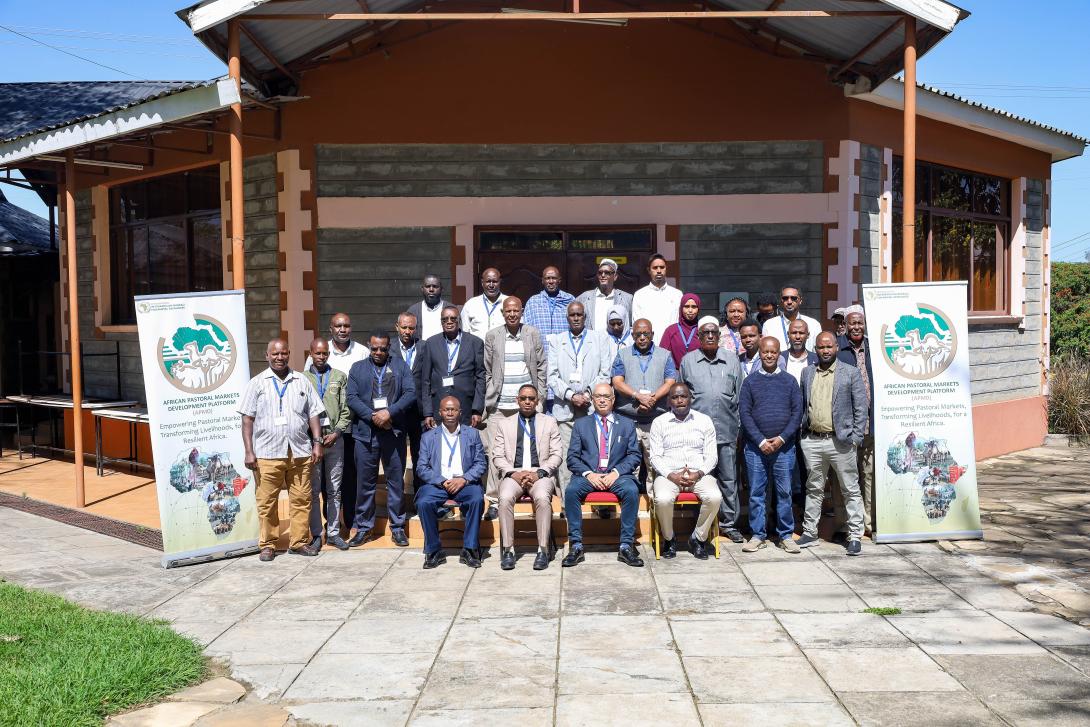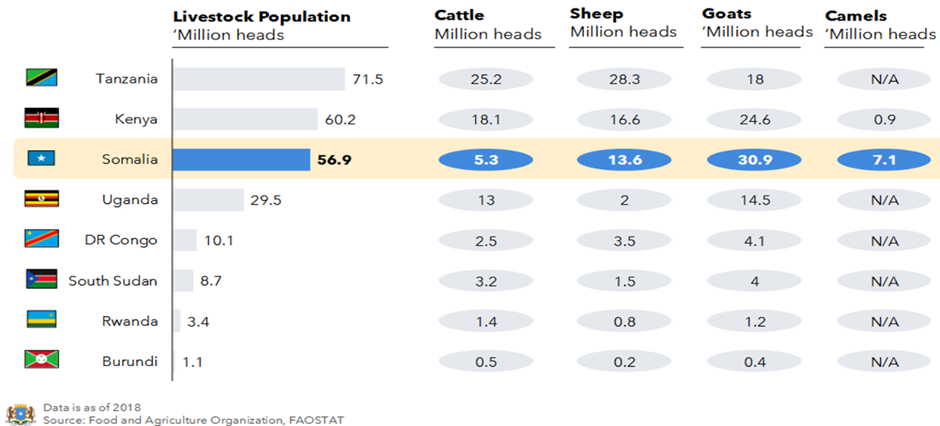
Towards a resilient feed and rangeland system in the Horn of Africa

 The Horn of Africa’s ASALs are home to more than half of Africa’s livestock, yet feed shortages, land degradation, alternative land use, and fragmented policy coordination threaten the livelihoods and regional food security. It is against this that AU-IBAR, through the African Pastoral Markets Development (APMD) Platform, has convened a regional workshop on strengthening feed and rangeland security, bringing government representatives from Kenya, Ethiopia and Somalia, researchers, private sector actors and pastoral community leaders to share practical solutions for building resilient feed and rangeland systems.
The Horn of Africa’s ASALs are home to more than half of Africa’s livestock, yet feed shortages, land degradation, alternative land use, and fragmented policy coordination threaten the livelihoods and regional food security. It is against this that AU-IBAR, through the African Pastoral Markets Development (APMD) Platform, has convened a regional workshop on strengthening feed and rangeland security, bringing government representatives from Kenya, Ethiopia and Somalia, researchers, private sector actors and pastoral community leaders to share practical solutions for building resilient feed and rangeland systems.
The workshop data reveals that the region’s livestock base is at 118 million cattle, 100 million goats, 104 sheep and 14 million camels, which account for half of Africa’s livestock population. Yet productivity remains low due to poor feed quality, seasonal shortages and limited investment in fodder production and conservation.
Feed availability is dominated by low quality natural pastures and crop residues, with commercial hay and silage production still at minimal. Rapid land conversion, invasive species, and unpredictable rainfall further straining the rangeland capacity. As a result, therefore, all the three countries face a chronic feed deficit, with Kenya operating at a 60 percent feed shortage that equates to about 2.6 billion missing bales annually.

Feed and rangeland security policy instruments
Under IGAD, the East Africa Feed and Feeding Strategy (EA-FFS) 2023–2037 presents a regional roadmap built on 4 strategic objectives to expand feed and water availability; to improve processing and utilization; to promote value addition and to embed resilience through gender, youth and innovation. The strategy is aimed at closing the chronic feed deficit across IGAD member states and turning pastoralism into a productive, climate-smart enterprise. For private investors, it offers a framework backed by governments, aligned with African Union (AU) and Food and Agriculture Organization (FAO) priorities and anchored on value chains that have demonstrated stability in market demand, therefore offering policy convergence that lower entry barriers for private capital.
Complementing this, the Regional Fodder and Rangeland Platform (RFRP), IGAD’s coordination hub, links governments, private actors and development partners to standardize quality, share data and guide regional investment. Barely three years in, the platform has realized great gains, including participatory rangeland management (PRM) guidelines, a pasture seed production manual and capacity building for cross-border communities. Looking ahead, the platform offers the potential for a regional feed information system, harmonized quality standards and an open investment space where public policy and private enterprises align. The platform offers and ecosystem for an increasingly organized, transparent and long-term engagement with financial service providers, agribusiness firms and producer cooperatives.
These frameworks have positioned the Horn of Africa’s feed sector as a regional market with continental reach capable of absorbing capital, generating trade and stabilizing livelihoods.
Country insights
Kenya’s feed demand is at about 55 million metric tons of dry matter, yet supply is less than half, which leaves the herds underfed, and smallholder farmers exposed to the volatility of drought and feed scarcity. A notable increase in the demand for animal-sourced food, estimated to hit 1.6 million tons of meat and about 10.5 billion liters of milk by 2030, Kenya’s feed industry is constrained by high production costs, inadequate data and relatively weak enforcement of feed quality standards.
Ethiopia’s Ministry of Agriculture’s latest assessment shows that feed availability is uncertain and is attributed to erratic rainfall, shrinking grazing land and the absence of formal forage seed systems. Further, the situation is strained by inadequate investment in feed technologies, limited access to affordable credit and weak coordination across institutions and regions. Despite these, the government has resolved the country’s feed sector as a policy priority backed by incentives such as tax breaks, infrastructure funding and new public-private partnerships to expand fodder seed multiplication, rangeland restoration and feed processing.
Somalia exports millions of live animals to Gulf markets, generating US$ 2.6 billion annually in revenue and accounts for the majority of rural incomes. According to FAO data, Somalia’s livestock require about 33 million tons of dry matter feed annually, but the actual availability is barely 22 million tons, translating into 34 percent in dry matter and over 40 percent in energy. Approximately 97 percent of the feed is from open grazing, leaving the country’s feed basket exposed to drought and rangeland degradation.
Value proposition for investment in commodities
Estimates from the Kenyan delegates placed the investment potential in the feed sector at US$ 3.4 billion if the policies are streamlined and incentives introduced. The sector’s investment value lies across three main areas. Feed production, including cultivated pasture, irrigated fodder, silage and hay processing that offers immediate returns that are driven by demand due to the increasing consumption of animal-sourced foods and expanding beef, dairy and poultry industries; Feed processing and input supply especially in seed multiplication, concentrate manufacturing and mechanized baling, providing medium-long term growth prospects supported by modernization efforts and regional trade integration under the African Continental Free Trade Agreement (AfCFTA); Supporting infrastructure such as storage hubs, logistics and quality certification facilities offer an open space public-private partnerships therefore reducing post-harvest loses and connecting producers to markets.
Kenya’s feed value chain presents an investment case, with an estimated investment of KES. 465.4 billion, an annual net return of KES. 174 billion can be generated with over 145,000 job opportunities created across the value chain. This forecast underscores the lucrative opportunity for private sector actors to strategically invest in high-demand crops that yield measurable returns.
|
Value Chain |
Inputs Analysis |
Output Analysis |
|||
|---|---|---|---|---|---|
|
Metric Tonnes |
Acres |
Total Cost (KES) |
Net Margin per Annum (KES) |
Jobs Created |
|
|
Maize |
3,123,851.76 |
1,156,982.13 |
76,436,487,315.17 |
38,218,243,658 |
13,649 |
|
Sorghum |
24,004,008,652 |
9,601,603,461 |
8,001 |
||
|
Cassava |
438,482.59 |
62,640.37 |
3,044,321,978 |
386,628,891 |
322 |
|
Soya |
204,625.21 |
5,669,351,109 |
1,133,870,222 |
945 |
|
|
Sunflower |
1,268,147.31 |
724,655.60 |
35,386,020,173 |
10,615,806,052 |
8,847 |
|
Cotton |
455,051.26 |
260,029.29 |
22,790,329,829 |
4,558,065,966 |
3,798 |
|
Lucerne (Alfalfa) |
4,296,495.82 |
529,091.74 |
54,427,667,560 |
8,164,150,134 |
6,803 |
|
Forage (Protein) |
|||||
|
Silage (Maize) |
1,310,427.00 |
204,701,802,327.78 |
81,880,720,931 |
68,234 |
|
|
Hay Grass |
584,973.27 |
38,928,800,895.73 |
19,464,400,447.86 |
16,220 |
|
|
Sub-Total |
5,404,248.26 |
465,388,986,642.87 |
174,023,519,784.65 |
145,020 |
|
|
Pastoral Feed |
95,039,122.56 |
||||
|
Ranch Feed |
10,144,852.96 |
||||
|
Grand Total |
110,588,223.78 |
465,388,986,642.87 |
174,023,519,784.65 |
145,020 |
Source: Kenya’s Ministry of Agriculture and Livestock Development.
Alongside the stable domestic consumption, the feed sector stands as one of the most commercially attractive agribusiness frontiers driven by the growing regional feed trade in the Horn of Africa.
With livestock feed in Ethiopia, Kenya and Somalia now recognized as a national priority for productivity and export competitiveness, the feed economy offers consistent demand, growing market scale and opportunities for integration across the value chain.
As the stakeholders deliberate on the translation of the policy instruments into practical action for strengthening feed and rangeland security, the path lies in the commercialization of fodder production, integration of early warning systems and the scale up of technologies that make feed production more resilient.
